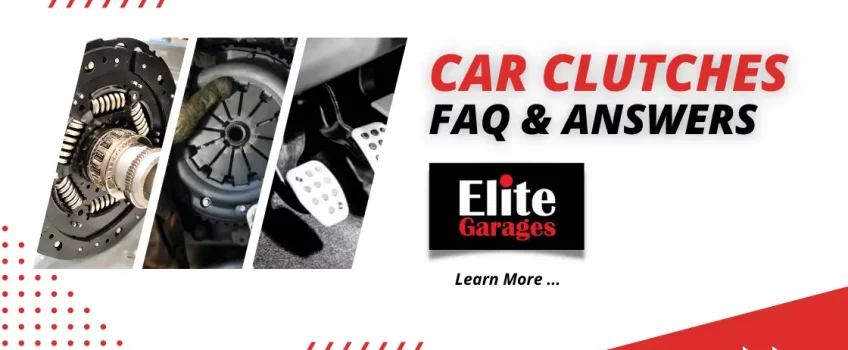
What Does A Car Clutch Do?
In simple terms, the clutch is essentially a connection between the engine and the gearbox. It works by using friction to send rotational power from the engine to the gearbox and then to the wheels. In this guide, learn from our clutch specialists as they answer some of the most frequently asked questions about clutches.
How Does A Clutch Work?
When you push down the pedal, it disengages the engine from the gearbox which allows you to change gear. The pedal is connected to a lever that sits on top of the clutch plate. As you push the pedal down, the lever moves and pulls the plate away from the flywheel. This breaks the connection between the engine and gearbox and prevents the engine from sending power to the wheels.
When you release the pedal, the spring-loaded pressure plate pushes the clutch plate back against the flywheel which re-establishes the connection between the engine and gearbox. The engine can now send power to the wheels again. This design allows drivers to disengage the wheels from the engine in order to change gear, giving them more control over their car’s speed.
Where Is A Clutch Located?
Located between the vehicle’s engine and gearbox, it consists of several different parts, including the following:
- Flywheel – Bolted to the back of the engine and provides a surface for the pressure plate to push against
- Pressure plate – Mounted on top of the flywheel and consists of a spring-loaded diaphragm that applies pressure to the clutch disc
- Clutch disc – Sits between the flywheel and pressure plate and is connected to the input shaft of the gearbox
- The throw-out bearing – Located on top of the pressure plate and is used to disengage the clutch when the pedal is pushed down
How Long Does A Clutch Last?
There is no definitive answer as to how long it will last as it depends on several factors from driving habits and vehicle usage to maintenance. In general, it should last anywhere between 20,000 and 60,000 miles.
Do You Hold The Clutch While Stopped?
You don’t have to hold the pedal down when you’re stopped at a light or in traffic. However, some drivers prefer doing this as it takes the weight off the engine and gearbox. It’s up to you whether you want to hold the pedal down or not. You only need to press the pedal down far enough to disengage the engine from the gearbox. Pushing the pedal all the way down will not make the clutch engage any faster.
What Happens If You Hold The Clutch Pedal Down For Too Long?
Holding the pedal down or leaving your car in neutral for too long will make you “freewheel”. This is also known as “coasting” which can be very dangerous since it reduces the amount of control you have of the vehicle.
The engine needs to be running in order to keep the car moving, so if you don’t give it enough gas while the clutch is engaged, it will eventually die. Additionally, holding the pedal down for too long can overheat and damage the components.
Recommended: What is coasting and why is it bad?
Can You Drive Without A Clutch?
No, you can’t as it’s essential for changing gears and coming to a stop. Without it, the engine would be unable to disengage from the gearbox which would make it impossible to change gears or stop the car. If it does stop working, the car will be unable to change gears or come to a stop which can be extremely dangerous. In this instance, contact your nearest clutch specialist and get it seen to as soon as possible.
Do You Press The Clutch When Braking?
No, you don’t need to press the clutch when braking as it’s only used for changing gears and coming to a stop. Pressing the pedal while braking will not engage the clutch any faster and can actually damage it.
How Do You Know When To Change Gears?
You’ll know when to change gears by the sound of the engine. When the engine is revving too high, it’s time to change up to the next gear. Conversely, when the engine is struggling and labouring, it’s time to change down to a lower gear.
Additionally, you can use the car’s speedometer to help you gauge when to change gears. In general, you should change up when you reach around 3,000 RPM and change down when you’re driving below 1,500 RPM.
What Are The Signs You May Have A Problem?
There are several symptoms that can indicate a problem, including the following:
- Pedal feels soft or spongy, hard or stiff
- Pedal is low to the floor than usual
- Clutch is slipping
- Grinding noise when shifting gears
- Burning smell coming from the engine bay
What Are The Most Common Car Clutch Problems?
- Worn Out Clutch: The most common problem with car clutches is that they simply wear out over time. The clutch disc and pressure plate can both become worn down, causing the clutch to slip or not engage properly.
- Misaligned Clutch: If the clutch is misaligned, it can cause difficulty shifting gears or slipping.
- Faulty Pressure Plate: If the pressure plate is not working properly, it can cause the clutch to slip or not engage properly.
- Leaking Hydraulic Fluid: If there is a leak in the hydraulic fluid system, it can also result in the clutch slipping or not engaging properly.
Vehicle Repairs And Servicing At Elite Garages
Clutch replacement costs can be fairly high which is why you should always use an accredited and qualified service centre. At Elite Garages, our clutch specialists can advise you on any repairs or replacements you may need. Our technicians only use original parts recommended by the manufacturer. They will let you know what the repair entails and provide you with a no-obligation quote.
Visit any of our centres for a free vehicle check and specialist advice if you think yours is on the way out. Apart from clutch repairs or replacements, we also offer MOTs, servicing, tyres, brakes, exhausts, batteries and wheel alignment among others.
About Us
Opening Times
Saturday : 8:30–4:00
Sunday : closed
More Information
Contact UsCustomer Information Pack
Check MOT Due Date
Free MOT reminder
Careers


